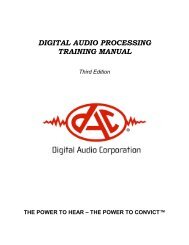QuickEnhance® VST User's Manual - Digital Audio Corporation
QuickEnhance® VST User's Manual - Digital Audio Corporation
QuickEnhance® VST User's Manual - Digital Audio Corporation
You also want an ePaper? Increase the reach of your titles
YUMPU automatically turns print PDFs into web optimized ePapers that Google loves.
5.2 NOISE<br />
Man, do we have a noisy world!<br />
Now that we understand sound, let’s talk about a special kind of sound ⎯<br />
noise. For our purposes, anything but the voice signal in which we are<br />
interested is classified as noise. There is a lot of noise around: in the<br />
house, at the office, in traffic, at the park…everywhere. In some places<br />
they even add noise so that you don’t notice other noises. We are<br />
constantly exposed to noise. Most of the time, it just makes our good tape<br />
recordings a little bit harder to understand, but sometimes the noises are<br />
so loud that we wonder whether there are actually voices on the tape!<br />
We classify noises into three categories: additive, convolutional, and<br />
distortion. The sketch below shows a typical recording scenario and<br />
some of these noises. We will discuss each of the three categories<br />
separately.<br />
Figure 9: Noise Model<br />
5.2.1 Additive<br />
The most common of the noises we encounter are additive. These noises<br />
are anything that generates an audible sound. The list is endless:<br />
engines, motors, fans, florescent light buzz, radios, TV, juke box, music<br />
bands, glass breaking, paper rustling, wind, etc., etc., etc.. For audio<br />
clarification purposes, these additive noises can be classified into two<br />
general categories: random and time-correlated. Certainly you know<br />
15
















